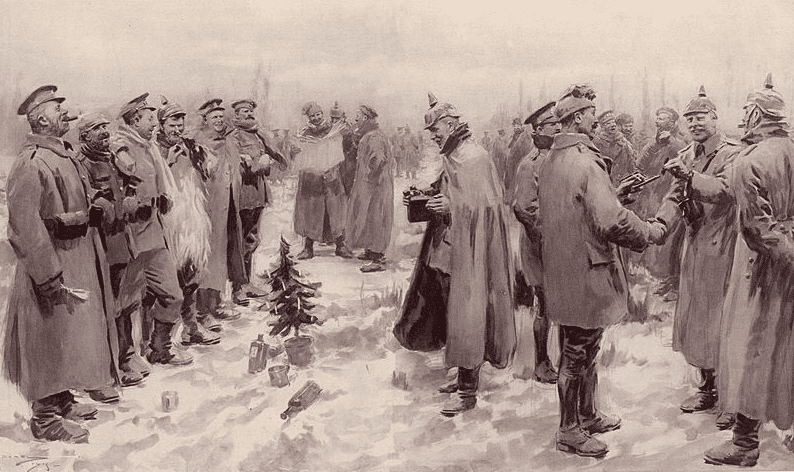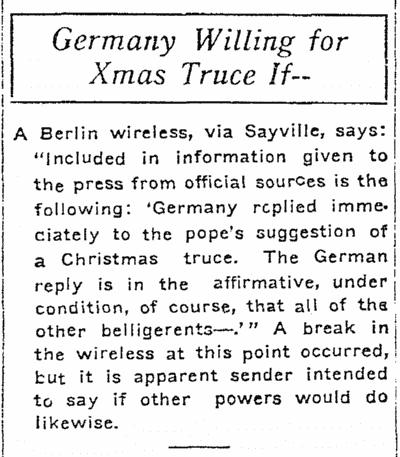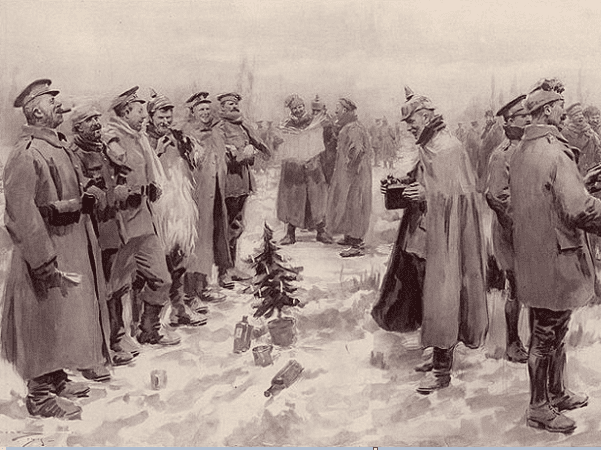Introduction: In this article, Gena Philibert-Ortega tells a remarkable story: how the power of Christmas – with its hope of “peace on earth, good will to men” – temporarily stopped the fighting during WWI in 1914. Gena is a genealogist and author of the book “From the Family Kitchen.”
By December 1914, Germany, Britain, France, and other European nations had been fighting since August. Trenches were dug on the Western front in September and those trenches, now home to soldiers, meant a holiday that would be cold, wet, and miserable tinged with the constant threat of death. What was first thought of as a “great adventure” by many young men must have quickly turned into a harsh cold reality as the casualties rose.
Then Christmas time approached, and something wonderful happened.

Pope Benedict Calls for Christmas Truce
In an attempt to stop the fighting for Christmas that year, Pope Benedict called on the warring nations to declare a Christmas truce. Initially, Germany was reportedly agreeable to a truce – but only if the other countries agreed.

Pope’s Plea Denied
But not every country was in agreement about the Christmas truce, so the discussion of a lull in the fighting ended. By mid-December 1914 the American newspapers announced that an official cease fire was not to be.
The following newspaper article reported:
The thundering roll of heavy guns will be the Christmas chimes of Europe. It’s [sic] carols will be the cries of dying men. Across the sky toward which wise men looked for the star which guided them to a manger will dart the aircraft of hostile powers – the latest man-made engine for aiding the destruction of fellow men.
Thousands may die upon battlefields on this Christmas Day when the message of ‘Peace on earth, good will to men,’ is being again repeated in other parts of the world.
Andrew Carnegie Comments
Interestingly enough, though America was not yet engaged in World War I, there was an American industrialist who was against a Christmas-time truce. Steel magnate Andrew Carnegie weighed in with the opinion that a truce where the fighting would end momentarily and then commence after the holidays was “unchristianlike and immoral.” Instead he called for supporting President Woodrow Wilson in promoting and securing a permanent peace: “It is terrible that so many widows and orphans are being made because a few men wanted war.” (An interesting aside is that this newspaper article ends with the comment that Carnegie walked to the White House to see the President, but the President was out golfing.)
Brief Christmas 1914 Truce
While an official truce did not occur, many WWI soldiers took matters into their own hands, setting aside their weapons and reaching out to their enemies in the spirit of the season. There were in fact mini truces all along the trenches that Christmas. While some mythology surrounds the details, there is no doubt that there was an unofficial cease fire, and soldiers from opposite sides did interact peacefully in “No Man’s Land” for Christmas 1914. Recollections of those involved told of gift giving, singing, kicking balls around, and other friendly interactions.
This report from a Rhode Island newspaper announces “British and Germans Exchange Gifts During a Christmas Truce on Firing Line.” The article reports:
On Christmas morning two British soldiers, after signalling truce and good-fellowship from the perilous crown of their trench, walked across to the German line with a plate of mince pies and garniture and seasonable messages… and were sent back with packets of Christmas cards – quite sentimental – wreathed with mistletoe and holly, for distribution among their fellows.
Initially American newspapers reported that an unofficial truce would be declared in the trenches so that the men could eat their Christmas dinners in peace. While those in charge were providing their fighting men with some small luxuries (reportedly the French government sent their soldiers champagne), an unofficial momentary truce was about all that these soldiers could hope for.
Unfortunately, those fighting in World War I would see not only the Christmas of 1914 come and go with no peaceful solution to the war, but they would see three more Christmases bring fighting and lives lost – for some countries, almost wiping out an entire generation.
But for a brief time, that December 1914, soldiers on both sides laid down their weapons and enjoyed a little “peace on earth,” if only just for a short while.
Various stories of the Christmas truce can be found in historical newspapers and online. A dramatic narration done by Walter Cronkite accompanied by the Mormon Tabernacle Choir tells the story of the World War I Christmas truce and can be found on YouTube here: https://www.youtube.com/watch?v=tRq–pTnlog.
Related Articles:
